|

The
most famous Napier engine, the 12 cylinder Lion aircraft design
D. Napier & Son Limited was a British engine and pre-Great War (the "brass era") automobile manufacturer and one of the most important aircraft engine manufacturers in the early to mid-20th century. Their
post-First World War Lion was the most powerful engine in the world for some time between the 1920s and the 1930s, and their Sabre produced 3500 hp (2,600 kW) in its later versions.
HISTORY
David Napier, second son of the blacksmith to the Duke of Argyll, was born in 1785. While cousins became shipbuilders, he took engineering training in Scotland and founded the company in Lloyds Court, St Giles, London in 1808. He designed a steam-powered printing press, some of which went to Hansard (the printer and publisher of proceedings of the Houses of Parliament), as well as newspapers. They moved to Lambeth, South London in 1830.
Between 1840 and 1860, Napier was prosperous, with a well-outfitted factory and between 200 and 300 workers. Napier made a wide variety of products, including a centrifuge for sugar manufacturing, lathes and drills, ammunition-making equipment for the Royal Arsenal, Woolwich, and railway cranes. David's younger son James, born 1823, joined the firm in 1837, succeeding him as head of the firm in 1867, and after his father's death in 1873, specialised in beautifully crafted precision machinery for making coins and printing stamps and banknotes. James proved an excellent engineer, but a poor businessman, considering salesmanship undignified. It became so bad that there were as few as seven employees in 1895, and James attempted to sell the business, but failed.
James' son Montague, born 1870, inherited the business in 1895, along with his father's engineering talents. Montague was a hobby racing cyclist, and at the Bath Road Club, he met "ebullient Australian" S. F. Edge (then a manager at Dunlop
Rubber and colleague of H. J. Lawson in London, and amateur racer of motor tricycles.) Edge persuaded Napier to improve his Panhard ("Old Number 8", which had won the 1896 Paris–Marseille–Paris), converting from a tiller to a steering wheel and improving the oiling.
Dissatisfied, Napier offered to fit an engine of his own design, an 8 hp vertical twin, with electric ignition, superior to the Panhard's hot tube
type. Edge was sufficiently impressed to encourage Napier to make his own car and collaborated with Harvey du Cros, his former boss at Dunlop, to form the Motor Power Company, based in
London, which agreed to buy Napier's entire output. The first of an initial order of six, three each two-cylinder (8 hp or 6.0 kW) and four-cylinder (16 hp or 12 kW), all with aluminium bodies by Arthur Mulliner of Northampton and chain drive, was delivered 31 March 1900; Edge paid £400 and sold at £500.
In 1912, following a dispute with Edge, Napier bought Edge's distribution and sales company and production rose to around 700 cars a year with many supplied to the London taxi trade. That year, only six models were produced. The last Napier car was designed by A. J. Rowledge, who also designed the Lion (and who went to
Rolls-Royce in 1921), a 40–50 hp (30–37 kW) 377 cu in (6,178 cc) (101.6 mm × 127 mm or 4.00 in × 5.00 in) alloy six with detachable cylinder head, single overhead camshaft, seven-bearing crankshaft, dual magneto and coil ignition, dual plugs, and Napier-SU carburettor; it was bodied by Cunard, then a subsidiary. 187 were built in all by 1924, and Napier quit car production with a total of 4,258 built.
Outside the racing program, Napier also gained notoriety in 1904 by being the first car to cross the Canadian Rockies: Mr. and Mrs. Charles Glidden (sponsors of the Glidden Tours) covered 3,536 mi (5,691 km) from Boston to Vancouver.
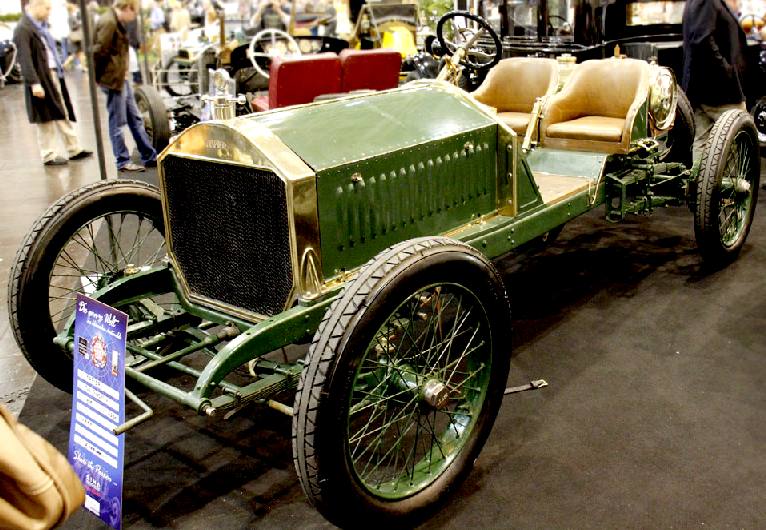
RACING PR
Recognising the value of publicity gained from racing, which no other British marque
did, in spring, Edge entered an 8 hp (6 kW) Napier in the Thousand Miles (1,600 km) Trial of the Automobile Club on behalf of Edward Kennard; driven by Edge, with Kennard along, on a circuit from Newbury to Edinburgh and back, it won its class, being one of only thirty-five finishers (of sixty-four starters[6]) and one of just twelve to average the requisite 12 mph (19 km/h) in England and 10 mph (16 km/h) in Scotland.
By June 1900, eight "16 hp"s had been ordered, and Edge entered one in the 837 mi (1,350 km) Paris-Toulouse-Paris race, with Rt. Hon. Charles S. Rolls (co-founder of
Rolls-Royce) as riding mechanic. The 301.6 cu in (4.94 L) (101.6×152.4 mm, 4x6 in) sidevalve suffered problems with its ignition coils and cooling system, and failed to finish.
For 1901, Montague designed a car sure not to lack speed, having a 16.3 liter (995.5 cu in) (165.1×190.5 mm, 6.5×7.5 in) sidevalve four capable of 103 bhp (77 kW) at 800 rpm, on a wheelbase of 115 inches (2.921 m) with four-speed gearbox and chain drive. Called the "50 hp", only two or three were completed, including one for Rolls. Edge entered one in the 1901 Gordon Bennett Cup, only able to test it en route (it was completed 25 May, only four days before the event), Montague serving as his riding mechanic; it overpowered its Dunlops, and fitting new (French) tyres led to disqualification, since they were not of the same nation of origin. In the concurrent Paris-Bordeaux rally, it retired with clutch trouble.
For the 1902 Gordon Bennett, three entrants (the Charron-Girardot-Voigt, a Mors and a Panhard) contested for
France, with Edge in a Napier and two Wolseleys. The Napier was a three-speed, shaft-drive 6.44 litre (392.7 cu in) four (127×127 mm, 5x5 in) of 44.5 hp (33 kW) (though described as a 30 hp). Piloted by Edge and his cousin, Cecil, it wore what would become known as British racing green, and won at an average 31.8 mph (51.2 km/h); although by default, since all other entrants retired during the race. It was the first British victory in international motorsport, and would not be repeated until Henry Segrave took the French Grand Prix in 1923.
Napiers also inspired Charles J. Glidden to create the Glidden Tours in upstate New York, which in turn persuaded Napier to build a factory in Boston. It, along with the Genoa factory (managed by Arthur McDonald), which built Napiers under licence as San Giorgios from 1906–9, was not a success.
Annual production reached 250 cars in 1903, overwhelming the Lambeth factory, so a move was made to a new 3.75-acre (1.52 ha) plant at Acton, in west London. On 16 October of that year, Napier announced a six-cylinder car for 1904 and became the first manufacturer to make a commercially successful six, a "remarkably smooth and flexible" vehicle 18 hp (13 kW) 301 cu in (4.9 liter) (101.6×101.6 mm, 4×4 in) with a three-speed gearbox and chain drive.[9] Within five years, there were 62 makers of six-cylinder cars in Britain alone, including the Ford Motor Company's 1906 Model K.
Napier's 1902 win brought the Gordon Bennett hosting duties to the United Kingdom, and the 1903 event was held south of Dublin, with three shaft-driven Napiers defending the British and Irish honour, all in the (later famous) racing green: two 470 cubic inch (7708 cc) 45 horsepower (33.5 kW) fours for Charles Jarrott and J. W. Stocks, with McDonald, the Genoa plant manager, his riding mechanic, and an 80 horsepower (838 cubic inch, 13,726 cc), the Type K5, for Edge. Jarrott and Stocks crashed, and Edge was
disqualified for receiving outside assistance when onlookers helped to throw buckets of water over his wheels to cool the tyres. It was a bad year for Napier's racing program; a 35 horsepower (26 kW) in the hands of Colonel Mark Mayhew in the Paris-Madrid rally lost its steering and hit a tree. Edge, again with McDonald, fared no better with the K5 in the 1904 Gordon Bennett in
Germany, but a new 920 cubic inch (15 litre; 158.7×127 mm, 6.25×5 inch) six, the L48, with an external radiator reminiscent of the Cord 810, set the fastest time at the Velvet Strand speed trials at Portmarnock, Ireland, in September, piloted by McDonald.
In January 1905, the L48, again with McDonald in the seat, took the mile (1.6 km) record at Ormonde Beach at 104.65 mph (168.41 km/h); although this was shortly broken by Bowden's Mercedes, the run was disallowed. The versatile McDonald ran the L48 in the 1905 Gordon Bennett qualifying event at the Isle of Man, taken over for the race by works driver Clifford Earp, who placed ninth.
Edge's secretary, Dorothy Levitt, drove a 100 hp (74.6 kW) development of the K5 at the Blackpool and Brighton Speed Trials in 1905, and the next year ran the L48 at the Blackpool Speed Trials, showing talent by equalling Edge's speed and setting a women's record in the flying kilometre of 90.88 mph (146.25 km/h).
By 1907, 1200 people were employed by Napier and were making about a hundred cars a year, aided by continuing racing success.
Brooklands opened that year, where Napier engineer H. C. Tryon won the first ever event in a 40 hp (30 kW), and Edge made a famous 24-hour run in June, covering 1,581 miles (2,544 km) at an average 65.905 mph (106.06 km/h) in a 60 horsepower (44.7 kW) 589 cubic inch (9,652 cc) (127×127 mm, 5×5 inch) six, a record which stood for 18 years. The L48, nicknamed Samson, became famous there in the venue's first two years; in 1908, Napier's Frank Newton covered half a mile (800 m) at 119.34 mph (190.05 km/h) in a stroked (178 mm, 7 inch) L48.
The company's last race win was with a four-cylinder at the 1908 Tourist Trophy, using an alias, Hutton, to preserve the reputation of the sixes, in the hands of Willy Watson. At the French Grand Prix, officials showed the perverse reasoning for which they later became notorious by claiming that removable wire wheels were an unfair advantage.
When Napier was no longer in racing, their Lion aero engine was used by several land speed record contestants:
Malcolm Campbell's Napier-Campbell Blue Bird of 1927 and Campbell-Napier-Railton Blue Bird of 1931,
Segrave's Golden Arrow of 1929, and John Cobb's Napier-Railton and
Railton Mobil
Special, which held the record from 1939–1964.
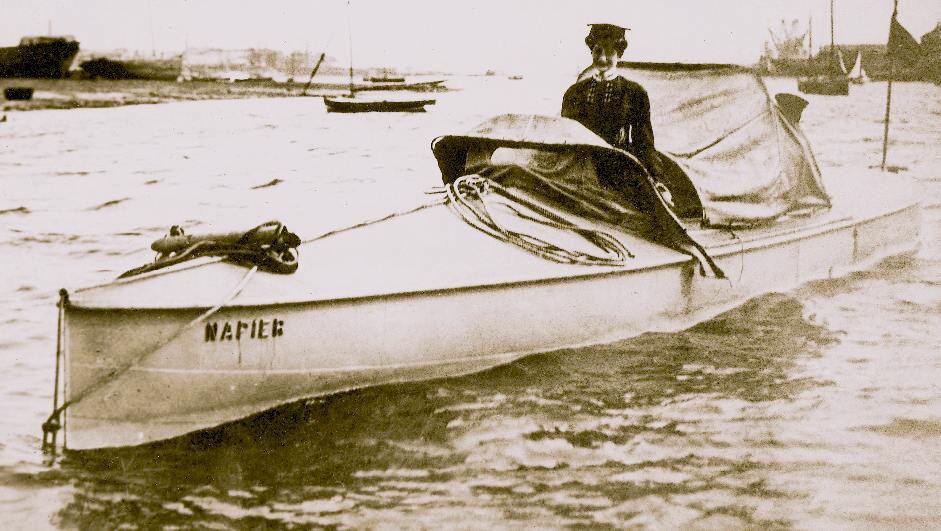
MOTOR BOATING
Napier expanded into marine engines and launches. In 1903 a S. F. Edge's Napier launch won the inaugural British International Harmsworth Trophy for speedboats at Cork Harbour in Ireland, driven by Dorothy Levitt. She achieved 19.3 mph (31.1 km/h) in a 40-foot (12 m) steel-hulled, speedboat fitted with a 3-blade propeller. As both the owner and entrant of the boat, "S. F. Edge" is engraved on the trophy as the winner. The third crew member, Campbell Muir, may also have taken the controls.
On 8 August 1903 Levitt drove the Napier at Cowes and won the race. She was then commanded to the Royal yacht by King Edward VII where he congratulated her on her pluck and skill, and they discussed the performance of the boat and its potential for British government despatch work.
Later in August Levitt won the Gaston Menier Cupat Trouville, France. This was described as the five mile world's championship of the sea and the prize was $1,750 prize.
In October 1903 Levitt won the Championship of the Seas at Trouville, and the French government bought the boat for £1,000.
The 1905 boat Napier II set the world water speed record for a mile at almost 30 knots (56 km/h).
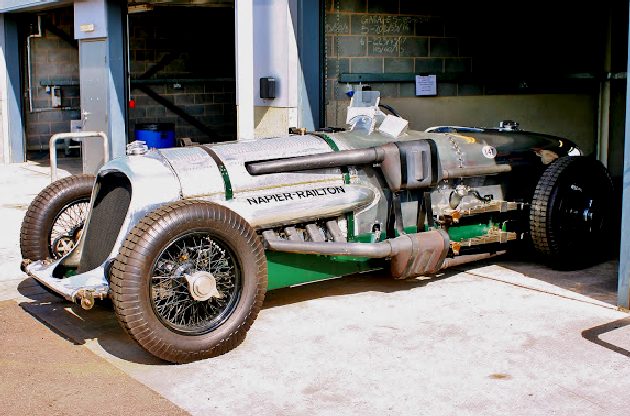
1914 - 1918 WWI
Early in the First World War, Napier was contracted to build engines from other companies' designs: initially the model RAF 3, a V-12 by Royal Aircraft Factory, and then the V-8 Sunbeam Arab. Both proved to be rather unreliable, and in 1916 Napier decided to design their own instead, an effort that led to the
superb W-block 12-cylinder Lion - with 3 rows of 4 cylinders. The Lion was a best-seller for the company, and they eventually dropped all the other aero-engines. The Lion went on to be used in to set the Land Speed Record in Malcolm Campbell's
Napier-Campbell Blue Bird and Campbell-Napier-Railton Blue Bird and Henry Segrave's Golden Arrow.
Vehicle production continued and 2,000 trucks and ambulances were supplied to the War Office. Montague Napier's health declined and in 1917 he moved to Cannes, France, but continued to take an active involvement in the company until his death in 1931.
During the First World War the company was contracted to build 600 aircraft at the Acton factory (50 Royal Aircraft Factory R.E.7, 400 Royal Aircraft Factory R.E.8 and 150 Sopwith Snipes).
In 1919 civilian car production recommenced with a 6-litre six-cylinder car, the T75. These were very expensive, costing about the same as a Rolls-Royce Silver Ghost and in the early 1920s sales declined. The last cars were made in 1924. An attempt was made to buy the bankrupt Bentley company in 1931 but Napier was outbid at the last minute by
Rolls-Royce. The last vehicle project was a three-wheeled tractor-trailer goods vehicle, but rather than produce this themselves they sold it to Scammell, who made several thousand.
In the 1930s the introduction of much larger and more powerful aero-engines from other companies suddenly ended sales of the Lion. Napier quickly started work on newer designs, building on experience gained on the X style 16-cylinder, 1,000 hp (746 kW) Cub, used in the Blackburn Cubaroo single-engined bomber of the 1920s, and the resulting later 16-cylinder Rapier and 24-cylinder Dagger were both air-cooled H-block designs. Neither the Rapier nor the Dagger proved very reliable, due to poor cooling of the rearmost cylinders, and even the Dagger's 1,000 hp (750 kW) was less than its competitors' offerings when shipped.
POST WORLD WARS
Last of the great Napier engines was the Nomad, a "turbo-compound" design that combined a diesel engine with a turbine to recover energy otherwise lost in the exhaust. The advantage of this complex design was fuel economy: it had the best specific fuel consumption of any aircraft engine, even to this day. However, even better fuel economy could be had by flying a normal jet engine at much higher altitudes, while existing designs filled the "low end" of the market fairly well. The Nomad was largely ignored by the market, and was duly cancelled.
Along with every other engine company in the post-war era, Napier turned to jet engine designs. Deciding to attack the only market not yet wrapped up by the larger vendors, Napier started the design of a number of turboprop designs which saw some use, notably in helicopters. Their first design, the Naiad and Double Naiad were intended for various Royal Navy Fleet Air Arm designs, but saw no use in the end. Smaller models, the 3,000-hp-class Eland and 1,500-hp-class Gazelle did somewhat better, notably the Gazelle which powered several models of the popular Westland Wessex
helicopter.
ENGLISH ELECTRIC
Napier had been taken over by English Electric in 1942. In 1961, Rolls-Royce purchased Napier's aero-engine business, and continued to market the Gazelle, dropping the Eland. Today Napier is no longer in the engine business, with the ending of the Deltic sales in the 1960s they had no new modern designs to offer. They continue on today as a primary supplier of turbochargers, which can be found on many engines.
RECENT HISTORY
GEC bought English Electric in the late 1960s. Later GEC became part of GEC-Alsthom and later Alstom. Siemens acquired the Napier business when it bought the Lincoln operations of Alstom in March 2003. Napier Turbochargers was bought from Siemens in June 2008 in a management buyout headed by the managing director, Andy Thacker. The buyout was funded by the private equity company Primary Capital and cost around £100 million. Early in 2013 Napier Turbochargers became part of Wabtec. Napier Turbochargers produces turbochargers for the marine, power and rail industries, employing around 150 people.
LINKS
and REFERENCE
http://www.kidselectriccars.co.uk/mercedes-300-sl-6v-electric-rideon-car-p-106.html http://www.martin-heukeshoven.de/details.php?idx=32 Benz
blogspot prototype mercedes-benz 300sl gullwing Wikipedia
Mercedes-Benz_300SL Telegraph
Goodwood Festival of Speed Mercedes-Benz 300SL gullwing review
Mercedes-Hamann
sls-amg in pink gold http://fancytuning.com/tag/mercedes-sls-amg/ http://www.madabout-kitcars.com/ http://www.madabout-kitcars.com/forum/showthread.php?t=157 Mercedes-destroys-knockoff-300sl-gullwing http://www.digitaltrends.com/cars/mercedes-destroys-knockoff-300sl-gullwing/#!WsJzX
Mercedes-Benz UK
Mercedes-Benz International
Mercedes-Benz Direct
- Buy Used Mercedes-Benz Direct from the UK http://en.wikipedia.org/wiki/Mercedes-Benz_SLS_AMG
http://www2.mercedes-benz.co.uk/sls_amg/
http://en.wikipedia.org/wiki/Mercedes-Benz_300SL http://benzs.blogspot.co.uk/2009/11/essen-2009-mercedes-benz-300sl-gullwing.html
http://en.wikipedia.org/wiki/Mercedes-Benz_SLK-Class
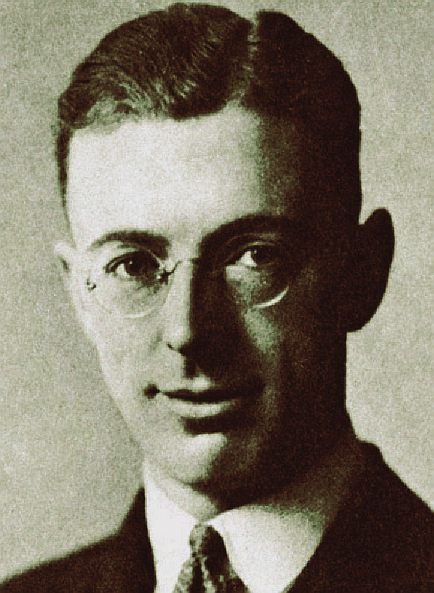
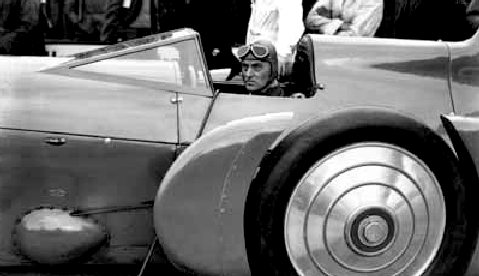

The
beautiful lines of the BE3 were inspired by Reid
Railton (pictured above left) and his designs for the Napier Lion
and Rolls
Royce engined Blue Bird LSR cars of the 1930s for Malcolm
Campbell. The Blueplanet BE3
features instant battery recharging using the patent
Bluebird™ cartridge exchange system under license from BMS.
This LSR car is also solar assisted. She is designed for speeds in
excess of 350mph using clean electricity - and what a spectacle she will
make charging along historic venues such as Pendine
Sands, Daytona
Beach and the Bonneville
Salt Flats.
|






